
Today, there are a variety of ways you can explore ChatGPT resources to help you grow your business and improve your guest experience.
That’s why we’ve put together this comprehensive guide that explores how to effectively use the free and paid travel ChatGPT resources available to strengthen your relationship with your customers.
How to craft a great ChatGPT prompt
Crafting a great ChatGPT prompt is the key to unlocking its full potential for your tour or attraction.
First, let’s dive into the art of creating clear, concise, and effective prompts that yield relevant responses from the chatbot.
Pro Tip: While ChatGPT strives to provide accurate and helpful information, it’s important to verify the responses it generates. The idea is to use these prompts as a starting point for further research.
1. Be clear and specific
When writing your ChatGPT prompt, be clear and specific about what you’re seeking. Avoid ambiguous or vague questions that may lead to unclear or generic responses. Instead, clearly state your question with as much detail as possible.
Example prompt: “I run a helicopter tour company in the New York City metro area. Can you provide a detailed explanation of how a helicopter tour operator, like me, can use Instagram to drive more bookings?”
ChatGPT advises the operator to create an Instagram Business Account, define its target audience, and share high-quality photos and videos, among other useful tips.
Then, we can get down to specifics — such as, “How often should I post?” and “What are the best times for engagement?” The more context and questions you ask, the more specifics you’ll get.
2. Provide context and background information
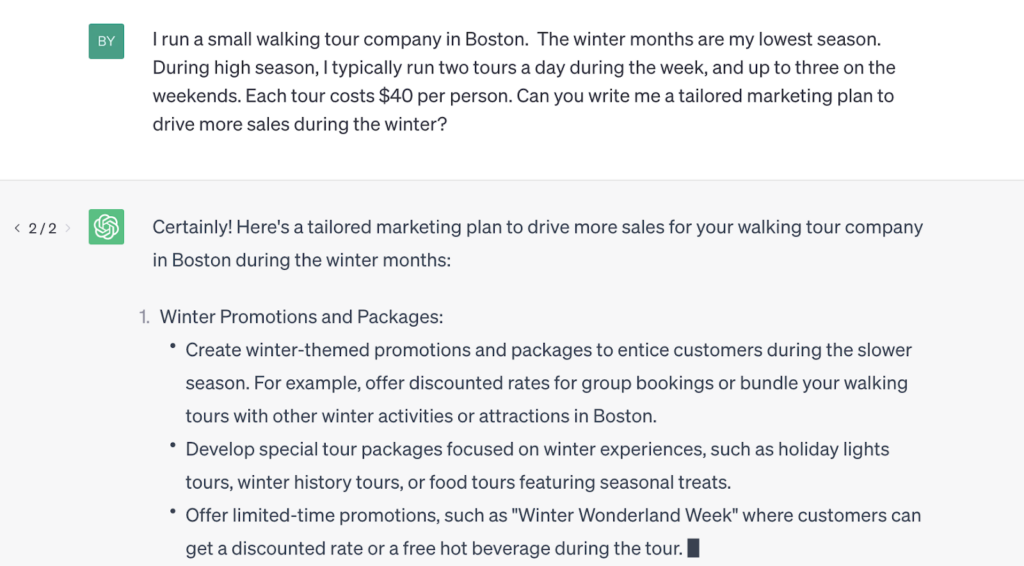
Remember that ChatGPT is an AI-powered tool. It is not aware of your company size or even the types of services offered. Providing relevant background information helps guide the conversation and provides a basis for more accurate and insightful responses.
Example prompt: “I run a small walking tour company in Boston. The winter months are my lowest season. During the high season, I typically run two tours a day during the week and up to three on the weekends. Each tour costs $40 per person. Can you write me a tailored marketing plan to drive more sales during the winter?”
The response breaks down the marketing plan into winter promotions and packages, targeted online ads, email campaigns, social media ideas, and collaborations with local businesses. Aside from campaign ideas, ChatGPT also provides an idea for a customer loyalty program, where customers earn discounts after a certain number of bookings.
To follow up, you can pose a more detailed question like, “What’s the best survey to use to segment my target audience based on their preferences, such as historical interests, cultural exploration, or family-oriented activities, to create more personalized marketing messages?”
3. Specify the format or type of response
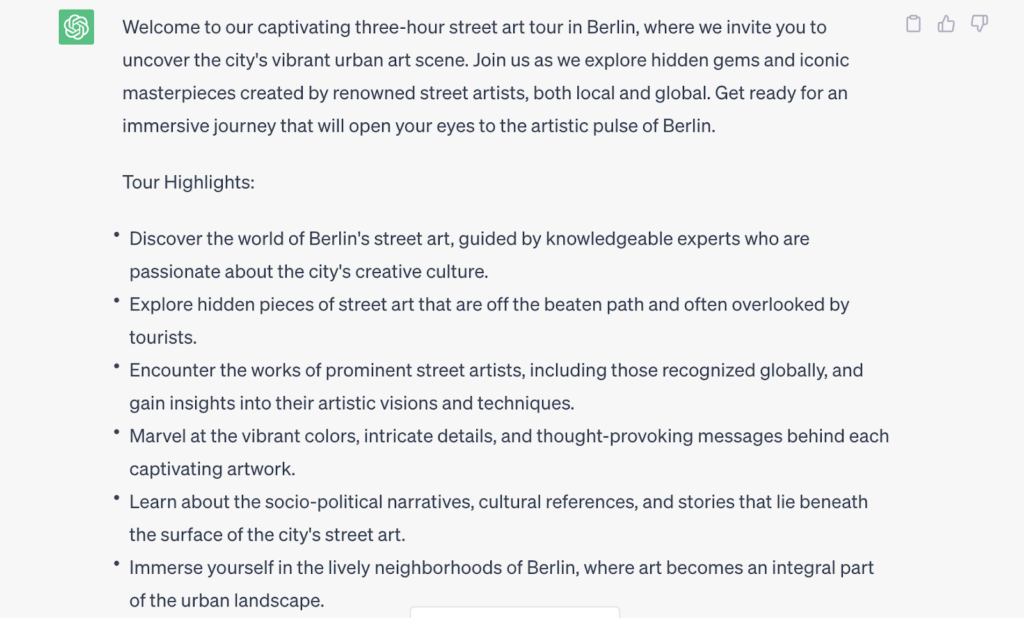
If you have a specific format or type of response in mind, clearly communicate it in your prompt. This helps ChatGPT understand your expectations and generate a response that meets your requirements.
An operator using ChatGPT to write tour descriptions will require a different response format than one looking for ideas on how to sell gift cards. Let’s look at how we would tackle the first example.
Example prompt: “I run a street art tour in Berlin. The tour lasts three hours. We discover the most prominent street artists in Berlin, including some known around the world. There are several hidden pieces of street art that tourists won’t find or recognize on their own. The tour lasts 3 hours. Pickup and drop-off points are East Side Gallery. Please write a tour description in the following format: a 2-3 sentence introduction, followed by a bullet point list with the highlights and important information regarding the tour.”
As you can see in the example above, the ChatGPT response was formatted according to the query. The chatbot also included an additional bulleted list with important information like tour duration and meetup location.
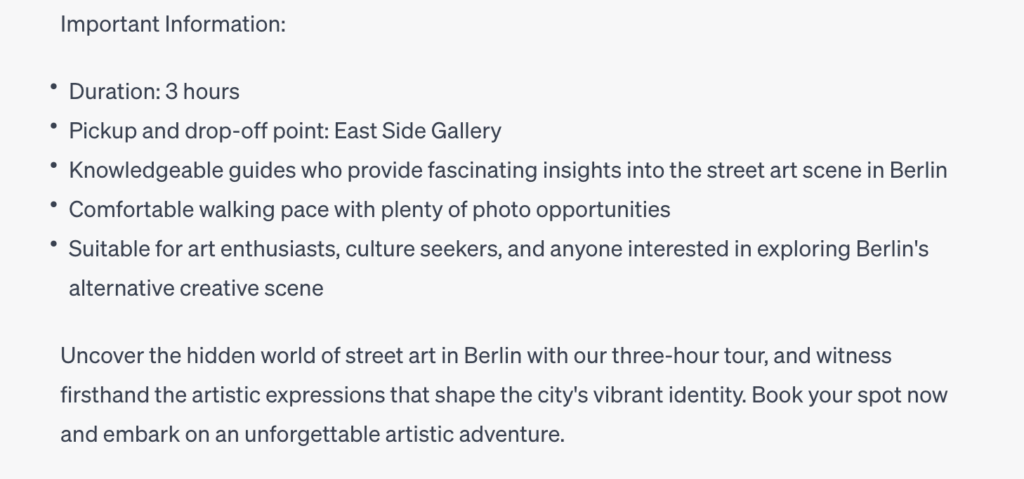
4. Ask open-ended questions
Let’s say you’re looking for a more detailed and elaborate response. When you ask open-ended questions — ones that require more than a “yes” or “no” response — you’ll receive more thoughtful answers.
Example prompt: “I’m an escape room operator in Greater Atlanta metro area. There are two more businesses entering our market and we are worried about our market share decline. Can you write me a concrete plan for how to increase my reviews online? Including survey templates and a calendar of when and how to send them?”
ChatGPT comes back with a full survey template for you to send to guests via email. This is then followed up with a schedule of when to send your emails:
- Day 1: Send a “Thank You for Visiting” email within 24 hours of their visit.
- Day 7: Send a follow-up email to customers who haven’t completed the survey.
- Day 14: Share positive reviews received so far on social media.
- Day 21: Send a mid-month check-in email to all customers.
- Day 28: Send a final reminder email to those who haven’t completed the survey.
5. Break down complex questions into smaller parts
If you have a complex question, consider breaking it down into smaller parts. This allows ChatGPT to address each component individually, leading to more focused and comprehensive responses.
First, start with the broader question. Let’s say you’re a new business trying to figure out how to best handle your bookings. You’re probably wondering if investing in booking software would make sense right now.
Example prompt: “At what point should a tour operator invest in booking software?”
You’ll receive a number of factors that would indicate your company could benefit from booking software, incluidng increased booking volume or resource constraints. Now, you can seek a more narrow response specifically about what your particular company should look for in booking software.
Example prompt: “I run a kayaking tour company in Miami, with a staff of four. I receive about 15 bookings per week. What are some features I should look for in booking software?”
ChatGPT can then provide a tailored list of factors to think about when looking for booking software. The more specific you are in your questions, the better the insight will be.
Top Free Ways To Use ChatGPT For Tours and Attractions
Fortunately, unlocking the power of ChatGPT doesn’t have to come with a hefty price tag. Let’s explore the top free ways tour operators and attractions can harness ChatGPT’s capabilities to enhance customer interactions, streamline operations, and offer personalized experiences.
1. Research
ChatGPT can be a valuable research tool for tour and attraction operators.
A walking tour operator, for instance, might use it to build its newest tour itinerary. Even if the operator is a local who’s familiar with the most famous sites in the city, it would be interesting to learn more about the visitor’s point of view.
The operator could ask, “What are the most popular landmarks in [city]?” or “What do visitors find most fascinating about [city]?”
ChatGPT can also be used to gain insights into your competitors’ offerings. While it doesn’t have access to real-time data, it can provide general insights about tour prices and the competitive landscape.
When asked about the average price for a walking tour in Miami, for instance, ChatGPT replied, “On average, walking tours in Miami can range from $15 to $40 per person for standard tours lasting a few hours. However, premium or specialized tours may have higher price points.”
2. Info retrieval
ChatGPT can be used to retrieve information about specific destinations, attractions, landmarks, or points of interest.
Operators can prompt ChatGPT with questions such as “Tell me about the history of the Eiffel Tower” and will be provided with detailed and relevant information. It can also be used to retreive information about the cultural significance of landmarks, such as Machu Picchu:
Prompt: “Tell me about the cultural significance of Machu Picchu.”
Response: “Machu Picchu is an ancient Incan citadel located in the Andes. It holds great cultural significance as a symbol of Incan civilization and was likely a royal estate…”
Or even geographical details about a specific tourist attraction:
Prompt: “Give me information about the geography of the Amazon Rainforest.”
Response: “The Amazon Rainforest is a vast tropical rainforest in South America, known for its incredible biodiversity. It spans across nine countries and covers approximately 6.7 million square kilometers…”
When prompting ChatGPT for information, remember to be specific and ask follow-up questions for the most accurate and detailed responses.
3. Streamline customer service
ChatGPT can also serve as a virtual customer service agent and address basic guest inquiries. In fact, it can be trained to answer your customers’ frequently asked questions. You can then integrate ChatGPT on your website or chat platform to enhance customer support and reduce response time.
TUI, a German tourism company, is using a ChatGPT-powered chatbot to help users find relevant tours and ticketed experiences in their specific destinations. Meanwhile, Kayak and Expedia have created plugins to streamline their virtual assistance and itinerary building capabilities.
4. Content idea generation
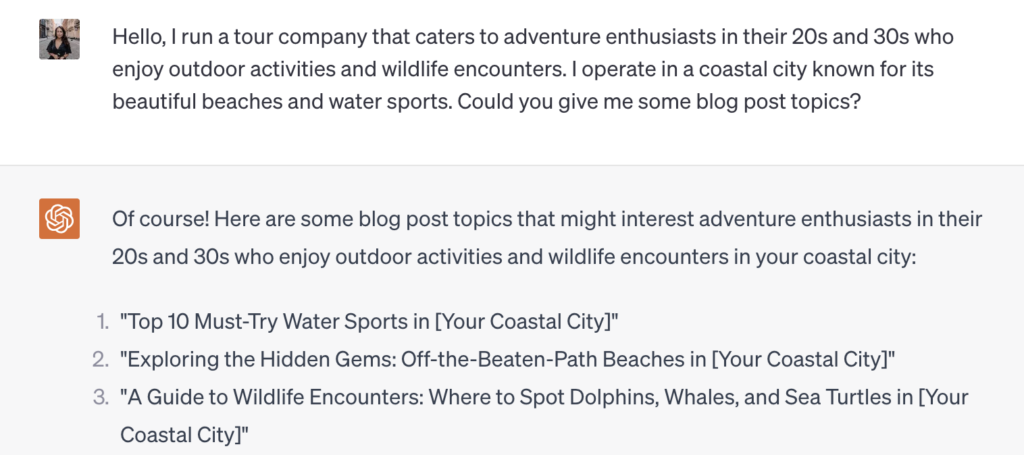
ChatGPT can help you explore a variety of content ideas, including:
- Blog post topics
- Social media post
- Marketing campaign ideas
- New tour ideas
First, you’ll want to describe your target audience. For example, you could say, “I run a tour company that caters to adventure enthusiasts in their 20s and 30s who enjoy outdoor activities and wildlife encounters.”
Then, specify the location: “I operate in a coastal city known for its beautiful beaches and water sports.”
Now that the platform understands a bit more about your company, you can ask it to generate blog ideas, social media posts, and marketing campaigns that would appeal to water sports enthusiasts, for instance.
Aim for more specific and creative responses by following these tips:
- Specify the parameters clearly. For example, “Give me three Instagram post ideas for the month of February.”
- Provide contextual background about your experience, audience, and location.
- Use analogies or comparisons. For example, “If my tour were a movie, what would be the most exciting scene?”
5. Travel planning
ChatGPT can assist in travel planning by providing recommendations, tips, and personalized suggestions for tours and attractions
A guest traveling to Spain can use ChatGPT to plan an itinerary. They may say something along the lines of: “I’m visiting Barcelona next month. Can you recommend some local food markets and popular landmarks to explore?”
Meanwhile, trip operators may find AI helpful in building and pricing new trip itineraries. Let’s say you want to launch a new itinerary in Morocco that caters to foodies and history buffs alike.
Here’s an example prompt: I am a group trip operator. I want to launch a new 7-day itinerary for Morocco that caters to foodies and history buffs. What might that itinerary look like?
As you’ll see in the screenshot below, ChatGPT provides you with an outline of what that itinerary might look like.
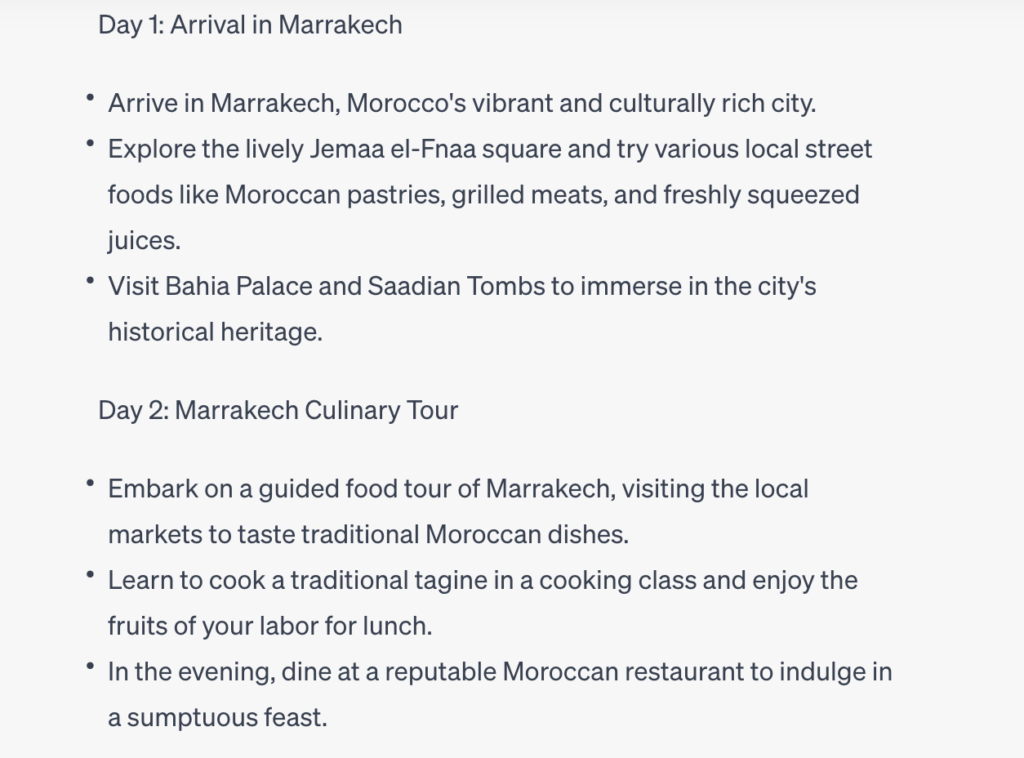
Meanwhile, Online Travel Agencies (OTAs) have launched plugins that can be integrated with the chatbot to make travel planning even easier.
Expedia, for instance, plans to use ChatGPT technology to provide travelers with hyper-personalized search results. When a traveler asks the chatbot about the top hotels for a particular destination, the suggestions would automatically be added to their Expedia trip board.
Meanwhile, Kayak’s plugin will help customers search for flights, stays, and rental cars. They’ll get tailored recommendations for all the places they can visit based on their budget. For example, a user can ask, “Where can I fly to from Miami for under $300?” and receive relevant destination ideas with ticket prices.
6. Personalized recommendations
If there’s one way to win your guests over in this day and age, it’s to offer them a hyper-personalized experience.
With ChatGPT, guests can provide details about the type of experience they’re looking for — such as “family-friendly adventure activities” or “interactive modern art museums.” ChatGPT will then suggest specific tours or attractions that align with a user’s preferences.
ChatGPT will recommend tours and attractions in its database, which is made up of information that was pulled off the Internet. If your website correctly depicts your services, your tour or attraction can be included in these recommendations.
On the operator front, allowing ChatGPT to access relevant data about past customer behavior can allow you to offer tailored recommendations. Integrate ChatGPT with your customer database to analyze past behavior patterns. This could include previous tour choices, feedback, and preferences of individual customers.
For a sightseeing tour operator, for instance, the recommendation could be a similar local activity, like a cooking class, based on past visits.
7. Virtual Tour Guidance
When physical travel isn’t an option, ChatGPT can act as a virtual tour guide. Through interactive conversations, the chatbot can provide virtual tours, share historical or cultural information about landmarks, and engage customers in a simulated travel experience.
By leveraging ChatGPT’s capabilities for personalized recommendations and virtual tour guidance, tour operators and travelers can enhance their exploration and enjoyment of tours and attractions — even in virtual or remote settings.
A walking tour operator might develop a script that prompts ChatGPT to narrate historical facts and anecdotes about landmarks. Operators can also incorporate multilingual support in its virtual tours, such as translating the script to French.
Top Paid ChatGPT Resources for Tours and Attractions
If you’re seeking to take your travel business to the next level, investing in premium ChatGPT resources can be a game-changer.
For one, ChatGPT is gradually rolling out plugins that bring the AI tool additional functionality. The plugins make it possible for users to access more information and perform more advanced tasks — like planning a trip from start to finish.
There are nearly a dozen plugins now, including fro Expedia, Kayak, and OpenTable. You can explore the plugins created in tandem with ChatGPT here.
These tools and services can help you elevate customer engagement, optimize workflows, and stay ahead of the competition with cutting-edge AI assistance.
1. ChatGPT travel plugins
ChatGPT travel plugins are paid extensions or integrations that enhance the chatbot’s ability to assist customers. These plugins can provide specialized features such as booking management, real-time availability updates, personalized recommendations, and seamless integration with existing travel systems.
The Expedia and Kayak plugins we mentioned previously are the perfect example. By integrating ChatGPT with the OTA’s platform, the plugins can personalize trip planning and provide customers with accurate, real-time information.
2. Custom travel planning chatbots
Custom travel planning chatbots are tailor-made virtual assistants designed to assist users in planning their travel experiences. These chatbots use ChatGPT technology to provide personalized recommendations, answer questions, and offer itinerary suggestions. They can be integrated into your websites or mobile apps, providing on-demand assistance to your customers.
Vacat Chatbot, for instance, helps plan a trip tailored to a traveler’s preferences. If a user says, “I want to go on a trip to France for a wine tour,” the chatbot will provide hotel and dining recommendations, tour ideas, and an itinerary suggestion.
Meanwhile, GuideGeek acts as a virtual travel assistant. Users can ask a range of travel questions, from “How do I spend 24 hours in Kyoto?” to “Where to take kids in London on a budget?”
3. Custom knowledge base chatbots
Custom knowledge base chatbots are built using ChatGPT to provide extensive information about tours, attractions, and destinations.
They are trained to offer detailed responses to user queries, including historical facts, logistical information, and frequently asked questions. For example, a scuba diving tour operator might train the chatbot to answer questions about the certification requirements to join a dive.
These chatbots provide quick and accurate responses to common user inquiries, ensuring your guests have reliable assistance 24/7. Here are two examples:
- Fin: A conversational chatbot answers customer queries based on your support content. Better yet, it learns from its users over time.
- Stonly: A knowledge base software that uses interactive guides to resolve customer issues.
4. Search Engine Optimization (SEO) AI tools
An SEO tool like SemRush analyzes search trends, user behavior, and competitor data to identify relevant keywords for your business. In other words, if you run an adventure tour company, an AI-powered SEO tool would help you find the right keywords to target in your website content. In turn, this would boost your visibility in relevant search queries made by your target audience.
Some tools help you improve your on-page SEO. Alli AI, for instance, automates time-consuming SEO tasks like creating meta tags, link descriptions, and alt descriptions for images, all of which impact your rankings on Google.
SEO.AI is another tool that uses AI-powered search tools to create content for you. The tool writes long SEO-rich articles that are optimized to rank on Google, allowing you to take leaps ahead in your content creation strategy. Note that AI-written articles wont necessarily match the tone and voice of your brand, which is why you’ll always want to edit them before publishing.
5. Virtual Tour Creation Platforms
Virtual tour creation platforms allow tour operators to create engaging and interactive virtual experiences of their attractions or destinations.
These platforms can leverage ChatGPT technology to provide a guided experience, answer questions, and offer insights as users navigate through the virtual tour. The difference between a virtual tour without AI technology and one that leverages ChatGPT is that in the latter, guests can receive on-demand information and guidance.
Here are a few examples of how virtual tourism is proliferating throughout the travel industry:
- Klapty: An online tool that allows operators to create, edit, and share their virtual tours.
- Airbnb Online Experiences: Airbnb uses Zoom for virtual tours and other activities hosted by experts via the online video platform.
- Google Arts & Culture: The platform allows users to take a virtual tour of The British Museum, Guggenheim Bilbao, MoMA, and more.
6. Sentiment analysis and feedback tools
Observing what your customers are saying about your online helps you identify trends, patterns, and dips in customer satisfaction. Moreso, it brings you valuable insight into their preferences. Is there a part of your experience they particularly like? Perhaps you could then create a marketing campaign centered on that.
Yet it can take a lot of time and effort to sift through every single review guests have left you, especially when there are so many review sites, to begin with.
Sentiment analysis and feedback tools use AI algorithms to analyze these reviews and relevant social media interactions related to your tours and attractions. This lifts a big weight off your shoulders.
For example, Social Searcher is a tool that makes it easier for you to search through all social media platforms for mentions of your brand. Meaning Cloud, on the other hand, can quickly analyze an unedited batch of customer feedback from emails and surveys, as well as social media comments and messages.
7. Voice and multilingual support
This is for tour and attraction operators whose experiences could benefit from voice-based and multilingual interactions. A few examples of voice or language plugins include:
- Play.ht: Converts articles, blog posts, courses, and more into audio using text-to-speech technology.
- Text to Audio: A WordPress plugin that lets your content be read aloud in over 20 languages.
- GSpeech: The plugin offers multilingual support, greeting audios, and speaking menus.
ChatGPT’s language capabilities cover more than 50 languages, making multilingual support more accessible than ever. Seamlessly communicate with international tourists through virtual assistants or chatbots powered by ChatGPT.
Voice support, then, can improve accessibility overall. ChatGPT also offers advanced features such as voice recognition, which allows your guests to receive responses from the chatbot without having to type out their requests manually.
***
With ChatGPT at your disposal, you can possess the tools to transform the way you engage with your customers and enhance their travel experiences.
From mastering the art of crafting effective ChatGPT prompts to exploring the top free and paid resources, you now have a comprehensive guide to navigating the world of AI-driven interactions.





